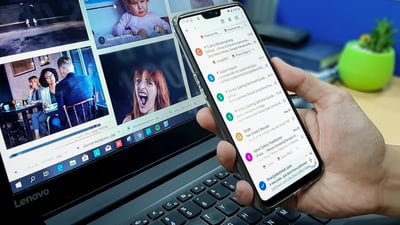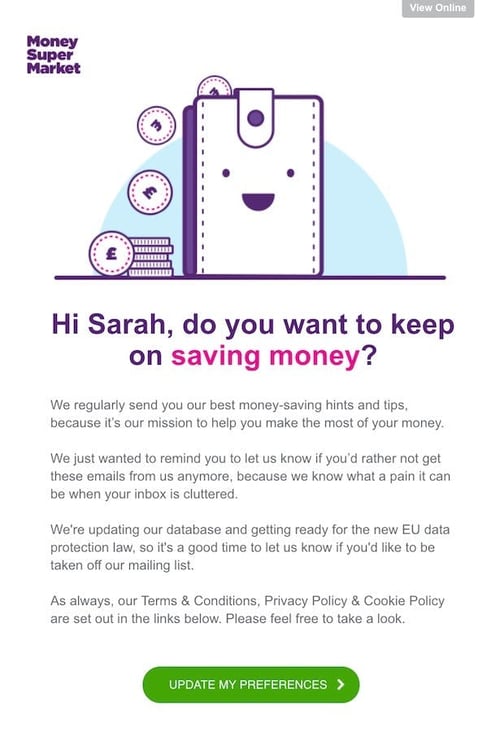
Don't you find that it's easier to walk into a room full of acquaintances or friends rather than a room full of new, unknown people? Isn't it easier to converse with someone when you already know their interests? The fact is - it's easier to engage with an existing contact or customer - and that's why database re-engagement campaigns can be so powerful.
If you're trying to think of new ways to attract new leads, think again! Your best leads might just be your existing customers. And now that you want to re-engage with them, you already have a head start: you have their contact details, you know their interest in your brand or content, and they may have even made a purchase from you before...
According to Outbound Engine, "acquiring a new customer can cost five times more than retaining an existing customer". This data point alone should make you jump at the chance to start an email re-engagement campaign today! In this post, discover tips and ideas to maximize your existing database.
Why embark on an email re-engagement campaign?
 There are many signs that it's time to start some new Marketing initiatives to re-engage your existing customers. In terms of email, you should be on the lookout for a lack of new email subscribers or declining email metrics (open rate, click rate, ROI). On the database side of things, you might be seeing stagnant or inactive workflows/processes. If your database charges you based on the number of contacts, be aware of a growing database full of inactive contacts. Finally, have your sales or deals fallen? These are all signs that you're not gaining productive, new leads.
There are many signs that it's time to start some new Marketing initiatives to re-engage your existing customers. In terms of email, you should be on the lookout for a lack of new email subscribers or declining email metrics (open rate, click rate, ROI). On the database side of things, you might be seeing stagnant or inactive workflows/processes. If your database charges you based on the number of contacts, be aware of a growing database full of inactive contacts. Finally, have your sales or deals fallen? These are all signs that you're not gaining productive, new leads.
Why might this be happening? There are a few potential reasons: Your customers may have lost interest in your emails or solutions. Maybe they found an alternative brand. If they were in the middle of the purchase or deal pipeline, perhaps they abandoned their intention to buy, didn't fully understand the product, or received no follow up from your end. Finally, maybe they are just simply forgetful. No worries! These are all things you can address in your re-engagement campaign.
What kind of content works best for email re-engagement campaigns?
 According to a Campaign Monitor survey, the top types of emails most likely to be opened by users are: personal correspondence, promotional offer/sale/discount from a familiar brand, and new products from a brand they love. We can summarize this into 3 P's: personalization, promotions, and products.
According to a Campaign Monitor survey, the top types of emails most likely to be opened by users are: personal correspondence, promotional offer/sale/discount from a familiar brand, and new products from a brand they love. We can summarize this into 3 P's: personalization, promotions, and products.
The survey also found users' favorite types of content to be: discount codes, exclusive sales, new product announcements, and content curated to their interests. This makes sense and supports the 3 P's we saw above.
These two findings give us an important look into the mindset of users, which you can use when developing your email strategy and curating content for re-engagement emails.
5 database re-engagement campaigns to try
1. GDPR Campaign
Acommon tactic for re-engaging the contacts in your database is an email opt-in campaign, also known as GDPR email campaigns. It's basically a way of updating the permissions of your contacts, in line with 2018 GDPR laws. Remember, your contacts must give explicit content: pre-ticked boxes or default settings don't work in this case.
This is a great way not only to stay up-to-date with the law, but also to discover which people on your mailing list are truly engaged. Be warned - you do risk losing a segment of your audience if they choose not to opt into your mailings. But the ones that stay will have actively chosen to keep receiving your content. It's better to clean out the people who aren't interested in your business and improve your tactics for the people who are. Scared to lose contacts? Remember that the top 10% of your customers spend 3x more than the bottom 90%, while the top 1% spends 5x more.
The key to a good GDPR campaign is the message of the email. It must be very compelling and speak to the curated content and deals that users will receive if they opt in. Take a look at this great example from Money Super Market; it features personalization, a compelling headline, a short description of the opt-in campaign, and a clear Call-to-Action button.

2. Win-Back Campaign
A win-back email campaign is a series of targeted and personalized messages you send to your lapsed customers. If they’re dormant, they often just need a gentle nudge to wake them up - SmartMail
Win-back campaigns are also called disengagement campaigns, re-activation or re-purchase campaigns. Many types of customers may fall into a win-back campaign: someone on your mailing list who has never made a purchase, a one-time buyer, a repeat purchaser who has gone dormant, or a completely lost client. Making a unique win-back campaign for each of these segments is key to the success of the campaign.
However, all win-back campaigns have a few elements in common:
- Triggered by a time frame or an event:It could be 3 months of inactivity or last product purchased. The trigger for your win-back campaign depends on your business and industry, and should take into account the average sales cycle, trends, etc.
- Not a one-off email: Win-back campaigns give customers several chances to stay involved. A good rule of thumb is to do at least 3 attempts per lead. Each attempt should be incorporated into an email nurturing sequence, so subsequent emails are automatically sent out based on contact behavior.
- Make it hard to say goodbye: Offer different content at each stage of the email nurturing sequence. Popular options include discounts, incentives, exclusive offers, and new products. When it's their last chance, make sure they know it.
3. Super-Segmentation Campaign
 As a Marketing professional, you already know that audience segmentation is extremely important. But for re-engaging a disinterested audience, you have to take segmentation even further. This involves doing a deep dive into your database and doing additional segmentation.
As a Marketing professional, you already know that audience segmentation is extremely important. But for re-engaging a disinterested audience, you have to take segmentation even further. This involves doing a deep dive into your database and doing additional segmentation.
Instead of the typical segmentation based on product or campaign, you want to go back to basics by identifying your Buyer Personas. Maybe there is a facet to your customers that you previously overlooked. Any information that can give you a better idea of the motivations, wants, and needs is something you can use to re-engage your audience.
Reach out to a small segment of important but disengaged users and ask for their feedback. Offer them a prize or incentive for the time they'll invest in helping you out. Taking the time and manual work to dive into these customers will pay off, and you can replicate your findings to more and bigger segments. You might be surprised at your findings and results.
4. Loyalty or Rewards Program
When customers feel that a brand values and supports them, they want to continue to support that brand with their loyalty. When given a chance, they'll choose them over the competition.
In this day and age, where competition is fierce between businesses, gaining customer loyalty is a true treasure. That's why it could make sense for your business to develop a loyalty or rewards program, and get your existing customers involved! Loyal customers spend 67% more than new ones. 58.7% of internet users believe earning rewards and loyalty points is one of the most valued aspects of the shopping experience.
Now, this doesn't have to just apply to retail. For B2B, this type of program can offer incentives, discounts, access to special services or programs, etc. Introduce an element of gamification by encouraging users to earn points or go up levels/tiers. They won't feel as if they're part of a rewards program, but like they're playing a game! Finally, create buzz and excitement with a contest or competition.
5. Referral Program
 Did you know that referrals account for65% of companies’ new deals? Because who do people trust more than their friends, family, and business associates? No one! In fact, people are 4 times more likely to buy when referred by a friend.
Did you know that referrals account for65% of companies’ new deals? Because who do people trust more than their friends, family, and business associates? No one! In fact, people are 4 times more likely to buy when referred by a friend.
Utilizing the personal and business network of your existing customers is an easy way to get potential new leads. For B2B, referral programs work by offering the referee a percentage of the final deal or retainer, or by getting sign-ups and purchases. They earn money just by referring their business associates. It's so easy! mbudo has a Referral Program.
Referral programs work best when you've established a strong brand network or community. You need to first work on your brand positioning and related campaigns; identify and collaborate with your top brand ambassadors; and make sure people know how to get involved with your program. But all of the work behind establishing a referral program is worth it: studies show that referred customers spend 25% more and are three times more likely to refer someone else.
With these ideas and tactics, you'll be able to start your first database re-engagement campaign via email. If you've already got an extensive database, put it to the test and see how much more engagement you can achieve! If you're interested in discovering everything else you can do with Email Marketing in HubSpot, contact mbudo. We are email experts and can help you get the most out of your Marketing strategy.

Mary Swick
Mary is a professional copywriter with over 10 years of experience in Marketing and Advertising. As an American expat in Madrid, she enjoys the relaxed Spanish culture, hiking, and the latest shows from Netflix and HBO. Mary also loves cats and music (she's the office DJ!)
It may interest you
LATEST
BLOG POSTS
SUBSCRIBE TO MBUDO BLOG
And get your inbound news directly in
your inbox, once a month.


